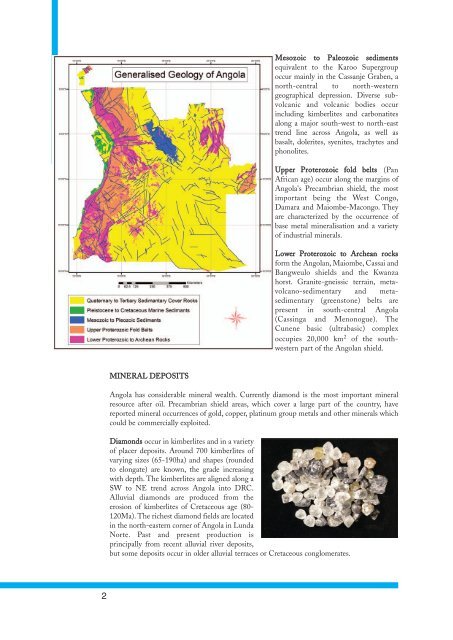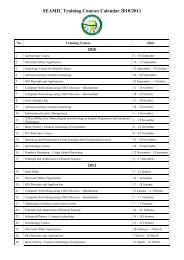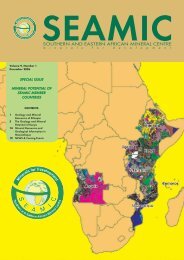SEAMIC Newsletter Vol. 10
SEAMIC Newsletter Vol. 10
SEAMIC Newsletter Vol. 10
Create successful ePaper yourself
Turn your PDF publications into a flip-book with our unique Google optimized e-Paper software.
Mesozoic to Paleozoic sediments<br />
equivalent to the Karoo Supergroup<br />
occur mainly in the Cassanje Graben, a<br />
north-central to north-western<br />
geographical depression. Diverse subvolcanic<br />
and volcanic bodies occur<br />
including kimberlites and carbonatites<br />
along a major south-west to north-east<br />
trend line across Angola, as well as<br />
basalt, dolerites, syenites, trachytes and<br />
phonolites.<br />
Upper Proterozoic fold belts (Pan<br />
African age) occur along the margins of<br />
Angola's Precambrian shield, the most<br />
important being the West Congo,<br />
Damara and Maiombe-Macongo. They<br />
are characterized by the occurrence of<br />
base metal mineralisation and a variety<br />
of industrial minerals.<br />
Lower Proterozoic to Archean rocks<br />
form the Angolan, Maiombe, Cassai and<br />
Bangweulo shields and the Kwanza<br />
horst. Granite-gneissic terrain, metavolcano-sedimentary<br />
and metasedimentary<br />
(greenstone) belts are<br />
present in south-central Angola<br />
(Cassinga and Menonogue). The<br />
Cunene basic (ultrabasic) complex<br />
occupies 20,000 km 2 of the southwestern<br />
part of the Angolan shield.<br />
MINERAL DEPOSITS<br />
Angola has considerable mineral wealth. Currently diamond is the most important mineral<br />
resource after oil. Precambrian shield areas, which cover a large part of the country, have<br />
reported mineral occurrences of gold, copper, platinum group metals and other minerals which<br />
could be commercially exploited.<br />
Diamonds occur in kimberlites and in a variety<br />
of placer deposits. Around 700 kimberlites of<br />
varying sizes (65-190ha) and shapes (rounded<br />
to elongate) are known, the grade increasing<br />
with depth. The kimberlites are aligned along a<br />
SW to NE trend across Angola into DRC.<br />
Alluvial diamonds are produced from the<br />
erosion of kimberlites of Cretaceous age (80-<br />
120Ma). The richest diamond fields are located<br />
in the north-eastern corner of Angola in Lunda<br />
Norte. Past and present production is<br />
principally from recent alluvial river deposits,<br />
but some deposits occur in older alluvial terraces or Cretaceous conglomerates.<br />
2




